Crocus is a genus in the Iridaceae family that is widespread, found in Europe, North Africa and in Asia. There are many species; the number varies depending on which resource you follow. Subspecies have been elevated to species levels and new species described, but both are not accepted by all. The standard reference on the genus was Brian Mathew, The Crocus, written in 1982, but at least half a dozen taxa, including new species, have been described since its publication. Other reference books that are helpful with this genus are The Smaller Bulbs and The Random House Book of Bulbs. A classic Crocus reference book is A Handbook of Crocus & Colchicum for Gardeners, by E. A. Bowles. It was first published in 1924 and is now out of date taxonomically, but it's an entertaining read by a legendary Crocus-lover. In 2010 Jānis Rukšāns published a book on Crocuses: A Complete Guide to the Genus that includes descriptions of species and cultivation information.
Crocus Species in the Garden was the topic of the week for the Pacific Bulb Society list in February 2003. This discussion was led by Tony Goode. Click on this link for his Introduction. His Crocus Pages can be found on the Scottish Rock Garden Club's website where you will find pdf files for individual species. The Alpine Garden Society's encyclopedia for Crocus has images of most taxa and basic information about all. John Lonsdale also has an extensive Crocus collection, and has posted photos at his Edgewood Gardens website. Smaller versions of a number of John's photos are reproduced in this wiki, with his permission. Another source is "The Country of Crocus" the 'blog' of İbrahim Sözen.
Some species bloom in the fall, before, with, or after leaf dehiscence, some in the winter, and some in the spring. Seasonality is relative on these pages, which means the bloom time varies depends on where the grower lives. Those that bloom in the fall need a warm summer dormancy. Those that bloom in the spring need a cold dormancy. Those that bloom in the winter seem to bloom in winter of Mediterranean climate which is rather mild with little to no frost. Since frost is the limiting factor, the following pages are separated into fall blooming, and spring blooming for simplicity.
Crocus species are susceptible to viral disease. This is usually visible in the flowers. This distortion may take the form of twisted petals, streaking (as in tulip fire), sometimes the flowers are depauperate and fail to open properly. The virus also reveals itself as light and dark blotching in the foliage which is most visible when the foliage first emerges. The first three pictures here from Tony Goode have been manipulated to exaggerate the streaking in flower and foliage to make it more apparent. (Massive hike in contrast levels does this.) The third picture shows ones with distorted petals. The vectors are aphids which find refuge especially on the backs of the leaves. See the Virus page for more information. The fourth photo below is of a plant with Cucumber Mosaic Virus (CMV) and the last is a photo of Crocus speciosus which is infected with CMV and Iris Severe Mosaic Virus. Photos 4-5 from Janos Agoston.
In general Crocus plants have very short stems; the seed pods only become visible at the end of the growing season, long after the flowers have vanished, when the stems elongate. Sometimes the seed pods remain at or below ground level. Seeds may be of the sweet sticky type attractive to ants and thus growing best when sown at 2 or 3 cm depth after washing. Each year a new corm grows on top of the old one, which then dies, often extra corms are also produced. A common characteristic is a white stripe down the middle of the ensiform leaf. Crocus enthusiasts are known as 'croconuts'. Photographs by David Pilling show seed pods, seeds on a 10 mm grid, corm development, a leaf and shoots of Crocus chrysanthus 'Romance' (left and characteristically of Crocus chrysanthus tinted yellow) and Crocus ancyrensis in mid-December. See Crocus Compared for comparisons of species.
More information and photos of species can be found by selecting the fall and spring blooming Crocus wiki pages listed below or by clicking on a specific species in the table below.
Fall Blooming crocus a-h - Fall Blooming crocus i-o - Fall Blooming crocus p-z - Spring Blooming crocus a-b - Spring Blooming crocus c-e - Spring Blooming crocus f-l - Spring Blooming crocus m-s - Spring Blooming crocus t-z
Fall Blooming crocus a-h - Fall Blooming crocus i-o - Fall Blooming crocus p-z - Spring Blooming crocus a-b - Spring Blooming crocus c-e - Spring Blooming crocus f-l - Spring Blooming crocus m-s - Spring Blooming crocus t-z
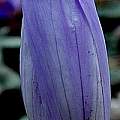
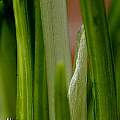
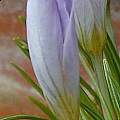
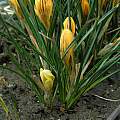
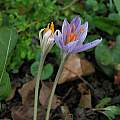
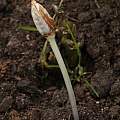
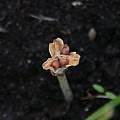
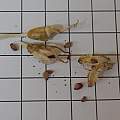
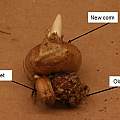
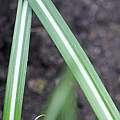
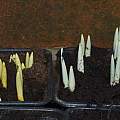
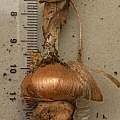
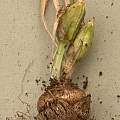
![Crocus abantensis, John Lonsdale [Shift+click to enlarge, Click to go to wiki entry] Crocus abantensis, John Lonsdale [Shift+click to enlarge, Click to go to wiki entry]](https://www.pacificbulbsociety.org/pbswiki/files/Crocus/th00---Crocus_abantensis_1_jl.jpg.jpg?svg=550x413)
![Crocus adamii, syn. Crocus biflorus ssp. adamii, John Lonsdale [Shift+click to enlarge, Click to go to wiki entry] Crocus adamii, syn. Crocus biflorus ssp. adamii, John Lonsdale [Shift+click to enlarge, Click to go to wiki entry]](https://www.pacificbulbsociety.org/pbswiki/files/Crocus/th00---Crocus_biflorus_ssp._adamii_0002_jl.jpg.jpg?svg=500x333)
![Crocus adanensis, John Lonsdale [Shift+click to enlarge, Click to go to wiki entry] Crocus adanensis, John Lonsdale [Shift+click to enlarge, Click to go to wiki entry]](https://www.pacificbulbsociety.org/pbswiki/files/Crocus/th00---Crocus_adanensis_3_jl.jpg.jpg?svg=550x413)
![Crocus aerius, John Lonsdale [Shift+click to enlarge, Click to go to wiki entry] Crocus aerius, John Lonsdale [Shift+click to enlarge, Click to go to wiki entry]](https://www.pacificbulbsociety.org/pbswiki/files/Crocus/th00---Crocus_aerius_2_jl.jpg.jpg?svg=550x413)
![Crocus alatavicus, John Lonsdale [Shift+click to enlarge, Click to go to wiki entry] Crocus alatavicus, John Lonsdale [Shift+click to enlarge, Click to go to wiki entry]](https://www.pacificbulbsociety.org/pbswiki/files/Crocus/th00---Crocus_alatavicus_Chimgan_1_jl.jpg.jpg?svg=550x413)
![Crocus aleppicus, John Lonsdale [Shift+click to enlarge, Click to go to wiki entry] Crocus aleppicus, John Lonsdale [Shift+click to enlarge, Click to go to wiki entry]](https://www.pacificbulbsociety.org/pbswiki/files/Crocus/th00---Crocus_aleppicus_0001_jl.jpg.jpg?svg=550x413)
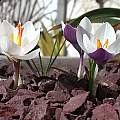
![Crocus ancyrensis, John Lonsdale [Shift+click to enlarge, Click to go to wiki entry] Crocus ancyrensis, John Lonsdale [Shift+click to enlarge, Click to go to wiki entry]](https://www.pacificbulbsociety.org/pbswiki/files/Crocus/th00---Crocus_ancyrensis_0004_jl.jpg.jpg?svg=800x600)
![Crocus angustifolius, Mary Sue Ittner [Shift+click to enlarge, Click to go to wiki entry] Crocus angustifolius, Mary Sue Ittner [Shift+click to enlarge, Click to go to wiki entry]](https://www.pacificbulbsociety.org/pbswiki/files/Crocus/th00---Crocus_angustifolius_msi.jpg.jpg?svg=600x399)
![Crocus antalyensioides, yellow Form, Martin Bohnet [Shift+click to enlarge, Click to go to wiki entry] Crocus antalyensioides, yellow Form, Martin Bohnet [Shift+click to enlarge, Click to go to wiki entry]](https://www.pacificbulbsociety.org/pbswiki/files/Crocus/th00---Crocus_antalyensioides_mbt1.jpg.jpg?svg=640x426x1024x683)
![Crocus antalyensis, John Lonsdale [Shift+click to enlarge, Click to go to wiki entry] Crocus antalyensis, John Lonsdale [Shift+click to enlarge, Click to go to wiki entry]](https://www.pacificbulbsociety.org/pbswiki/files/Crocus/th00---Crocus_antalyensis_1004_jl.jpg.jpg?svg=640x480)
![Crocus atticus, syn. Crocus sieberi ssp. atticus, Tony Goode [Shift+click to enlarge, Click to go to wiki entry] Crocus atticus, syn. Crocus sieberi ssp. atticus, Tony Goode [Shift+click to enlarge, Click to go to wiki entry]](https://www.pacificbulbsociety.org/pbswiki/files/Crocus/th00---Crocus_sieberiatticus.jpg.jpg?svg=413x550)
![Crocus asumaniae, Mary Sue Ittner [Shift+click to enlarge, Click to go to wiki entry] Crocus asumaniae, Mary Sue Ittner [Shift+click to enlarge, Click to go to wiki entry]](https://www.pacificbulbsociety.org/pbswiki/files/Crocus/th00---Crocus_asumaniae_msi3.jpg.jpg?svg=640x538)
![Crocus balansae, synonym Crocus olivieri ssp. balansae, John Lonsdale [Shift+click to enlarge, Click to go to wiki entry] Crocus balansae, synonym Crocus olivieri ssp. balansae, John Lonsdale [Shift+click to enlarge, Click to go to wiki entry]](https://www.pacificbulbsociety.org/pbswiki/files/Crocus/th00---Crocus_olivieri_ssp._balansae_0002_jl.jpg.jpg?svg=640x480)
![Crocus banaticus - divided style, Bob Rutemoeller [Shift+click to enlarge, Click to go to wiki entry] Crocus banaticus - divided style, Bob Rutemoeller [Shift+click to enlarge, Click to go to wiki entry]](https://www.pacificbulbsociety.org/pbswiki/files/Crocus/th00---Crocus_banaticus.jpg.jpg?svg=500x409)
![Crocus baytopiorum, John Lonsdale [Shift+click to enlarge, Click to go to wiki entry] Crocus baytopiorum, John Lonsdale [Shift+click to enlarge, Click to go to wiki entry]](https://www.pacificbulbsociety.org/pbswiki/files/Crocus/th00---Crocus_baytopiorum_0009_jl.jpg.jpg?svg=640x480)
![Crocus biflorus, John Lonsdale [Shift+click to enlarge, Click to go to wiki entry] Crocus biflorus, John Lonsdale [Shift+click to enlarge, Click to go to wiki entry]](https://www.pacificbulbsociety.org/pbswiki/files/Crocus/th00---Crocus_biflorus_0002_jl.jpg.jpg?svg=500x333)
![Crocus boryi, Jane McGary [Shift+click to enlarge, Click to go to wiki entry] Crocus boryi, Jane McGary [Shift+click to enlarge, Click to go to wiki entry]](https://www.pacificbulbsociety.org/pbswiki/files/Crocus/th00---Crocus_boryi.jpg.jpg?svg=640x480)
![Crocus cambessedesii, John Lonsdale [Shift+click to enlarge, Click to go to wiki entry] Crocus cambessedesii, John Lonsdale [Shift+click to enlarge, Click to go to wiki entry]](https://www.pacificbulbsociety.org/pbswiki/files/Crocus/th00---Crocus_cambessedesii_0002_jl.jpg.jpg?svg=550x413)
![Crocus cancellatus, Mark Mazer [Shift+click to enlarge, Click to go to wiki entry] Crocus cancellatus, Mark Mazer [Shift+click to enlarge, Click to go to wiki entry]](https://www.pacificbulbsociety.org/pbswiki/files/Crocus/th00---Crocus_cancellatus_cancellatus1.jpg.jpg?svg=510x550)
![Crocus candidus, John Lonsdale [Shift+click to enlarge, Click to go to wiki entry] Crocus candidus, John Lonsdale [Shift+click to enlarge, Click to go to wiki entry]](https://www.pacificbulbsociety.org/pbswiki/files/Crocus/th00---Crocus_candidus_0002_jl.jpg.jpg?svg=550x413)
![Crocus cartwrightianus, Jane McGary [Shift+click to enlarge, Click to go to wiki entry] Crocus cartwrightianus, Jane McGary [Shift+click to enlarge, Click to go to wiki entry]](https://www.pacificbulbsociety.org/pbswiki/files/Crocus/th00---Crocus_cartwr_CEH.jpg.jpg?svg=640x480)
![Crocus caspius by John Lonsdale [Shift+click to enlarge, Click to go to wiki entry] Crocus caspius by John Lonsdale [Shift+click to enlarge, Click to go to wiki entry]](https://www.pacificbulbsociety.org/pbswiki/files/Crocus/th00---Crocus_caspius_0001_jl.jpg.jpg?svg=550x413)
![Crocus chrysanthus 'Ard Schenk', David Pilling [Shift+click to enlarge, Click to go to wiki entry] Crocus chrysanthus 'Ard Schenk', David Pilling [Shift+click to enlarge, Click to go to wiki entry]](https://www.pacificbulbsociety.org/pbswiki/files/Crocus/th00---Crocus_chrysanthus_Ard_Schenk_DP2.jpg.jpg?svg=637x482)
![Crocus corsicus closeup, Mary Sue Ittner [Shift+click to enlarge, Click to go to wiki entry] Crocus corsicus closeup, Mary Sue Ittner [Shift+click to enlarge, Click to go to wiki entry]](https://www.pacificbulbsociety.org/pbswiki/files/Crocus/th00---Crocus_corsicus_msi2.jpg.jpg?svg=600x567)
![Crocus cvijicii, John Lonsdale [Shift+click to enlarge, Click to go to wiki entry] Crocus cvijicii, John Lonsdale [Shift+click to enlarge, Click to go to wiki entry]](https://www.pacificbulbsociety.org/pbswiki/files/Crocus/th00---Crocus_cvijicii_0002_jl.jpg.jpg?svg=800x600)
![Crocus cyprius, John Lonsdale [Shift+click to enlarge, Click to go to wiki entry] Crocus cyprius, John Lonsdale [Shift+click to enlarge, Click to go to wiki entry]](https://www.pacificbulbsociety.org/pbswiki/files/Crocus/th00---Crocus_cyprius_0004_jl.jpg.jpg?svg=550x413)
![Crocus dalmaticus, John Lonsdale [Shift+click to enlarge, Click to go to wiki entry] Crocus dalmaticus, John Lonsdale [Shift+click to enlarge, Click to go to wiki entry]](https://www.pacificbulbsociety.org/pbswiki/files/Crocus/th00---Crocus_dalmaticus_0003_jl.jpg.jpg?svg=550x413)
![Crocus danfordiae, John Lonsdale [Shift+click to enlarge, Click to go to wiki entry] Crocus danfordiae, John Lonsdale [Shift+click to enlarge, Click to go to wiki entry]](https://www.pacificbulbsociety.org/pbswiki/files/Crocus/th00---Crocus_danfordiae_0001_jl.jpg.jpg?svg=550x413)
![Crocus etruscus, John Lonsdale [Shift+click to enlarge, Click to go to wiki entry] Crocus etruscus, John Lonsdale [Shift+click to enlarge, Click to go to wiki entry]](https://www.pacificbulbsociety.org/pbswiki/files/Crocus/th00---Crocus_etruscus_Rosalind_0006_jl.jpg.jpg?svg=550x413)
![Crocus flavus, Jane McGary [Shift+click to enlarge, Click to go to wiki entry] Crocus flavus, Jane McGary [Shift+click to enlarge, Click to go to wiki entry]](https://www.pacificbulbsociety.org/pbswiki/files/Crocus/th00---Crocus_flavus_wild_form.jpg.jpg?svg=640x480)
![Crocus fleischeri, John Lonsdale [Shift+click to enlarge, Click to go to wiki entry] Crocus fleischeri, John Lonsdale [Shift+click to enlarge, Click to go to wiki entry]](https://www.pacificbulbsociety.org/pbswiki/files/Crocus/th00---Crocus_fleischeri_0006_jl.jpg.jpg?svg=550x413)
![Crocus gargaricus and Galanthus, Arnold Trachtenberg [Shift+click to enlarge, Click to go to wiki entry] Crocus gargaricus and Galanthus, Arnold Trachtenberg [Shift+click to enlarge, Click to go to wiki entry]](https://www.pacificbulbsociety.org/pbswiki/files/Crocus/th00---Crocus_gargaricus_1.jpg.jpg?svg=640x512)
![Crocus gilanicus, John Lonsdale [Shift+click to enlarge, Click to go to wiki entry] Crocus gilanicus, John Lonsdale [Shift+click to enlarge, Click to go to wiki entry]](https://www.pacificbulbsociety.org/pbswiki/files/Crocus/th00---Crocus_gilanicus_0005_jl.jpg.jpg?svg=550x413)
![Crocus goulimyi, M. Gastil-Buhl [Shift+click to enlarge, Click to go to wiki entry] Crocus goulimyi, M. Gastil-Buhl [Shift+click to enlarge, Click to go to wiki entry]](https://www.pacificbulbsociety.org/pbswiki/files/Crocus/th00---Crocus_goulimyi_MGB.jpg.jpg?svg=639x550x1489x1280)
![Crocus graveolens, John Lonsdale [Shift+click to enlarge, Click to go to wiki entry] Crocus graveolens, John Lonsdale [Shift+click to enlarge, Click to go to wiki entry]](https://www.pacificbulbsociety.org/pbswiki/files/Crocus/th00---Crocus_graveolens_1001_jl.jpg.jpg?svg=550x413)
![Crocus hadriaticus, Mary Sue Ittner [Shift+click to enlarge, Click to go to wiki entry] Crocus hadriaticus, Mary Sue Ittner [Shift+click to enlarge, Click to go to wiki entry]](https://www.pacificbulbsociety.org/pbswiki/files/Crocus/th00---Crocus_hadriaticus_msi.jpg.jpg?svg=640x459)
![Crocus hermoneus, John Lonsdale [Shift+click to enlarge, Click to go to wiki entry] Crocus hermoneus, John Lonsdale [Shift+click to enlarge, Click to go to wiki entry]](https://www.pacificbulbsociety.org/pbswiki/files/Crocus/th00---Crocus_hermoneus_0002_jl.jpg.jpg?svg=550x413)
![Crocus heuffelianus, Tony Goode [Shift+click to enlarge, Click to go to wiki entry] Crocus heuffelianus, Tony Goode [Shift+click to enlarge, Click to go to wiki entry]](https://www.pacificbulbsociety.org/pbswiki/files/Crocus/th00---Crocus_vernusvernusheuffelianus.jpg.jpg?svg=600x450)
![Crocus hyemalis, John Lonsdale [Shift+click to enlarge, Click to go to wiki entry] Crocus hyemalis, John Lonsdale [Shift+click to enlarge, Click to go to wiki entry]](https://www.pacificbulbsociety.org/pbswiki/files/Crocus/th00---Crocus_hyemalis_0028_jl.jpg.jpg?svg=550x413)
![Crocus imperati ssp. imperati, Mary Sue Ittner [Shift+click to enlarge, Click to go to wiki entry] Crocus imperati ssp. imperati, Mary Sue Ittner [Shift+click to enlarge, Click to go to wiki entry]](https://www.pacificbulbsociety.org/pbswiki/files/Crocus/th00---Crocus_imperati_imperati2_msi.jpg.jpg?svg=494x500)
![Crocus isauricus, syn. Crocus biflorus ssp. isauricus, John Lonsdale [Shift+click to enlarge, Click to go to wiki entry] Crocus isauricus, syn. Crocus biflorus ssp. isauricus, John Lonsdale [Shift+click to enlarge, Click to go to wiki entry]](https://www.pacificbulbsociety.org/pbswiki/files/Crocus/th00---Crocus_biflorus_ssp._isauricus_0005_jl.jpg.jpg?svg=800x592)
![Crocus × jessoppiae, Paige Woodward [Shift+click to enlarge, Click to go to wiki entry] Crocus × jessoppiae, Paige Woodward [Shift+click to enlarge, Click to go to wiki entry]](https://www.pacificbulbsociety.org/pbswiki/files/Crocus/th00---Crocus_x_jessopae_PW.jpg.jpg?svg=246x184)
![Crocus kerndorffiorum, John Lonsdale [Shift+click to enlarge, Click to go to wiki entry] Crocus kerndorffiorum, John Lonsdale [Shift+click to enlarge, Click to go to wiki entry]](https://www.pacificbulbsociety.org/pbswiki/files/Crocus/th00---Crocus_kerndorffiorum_0003_jl.jpg.jpg?svg=550x413)
![Crocus korolkowii, John Lonsdale [Shift+click to enlarge, Click to go to wiki entry] Crocus korolkowii, John Lonsdale [Shift+click to enlarge, Click to go to wiki entry]](https://www.pacificbulbsociety.org/pbswiki/files/Crocus/th00---Crocus_korolkowii_0005_jl.jpg.jpg?svg=640x480)
![Crocus kosaninii, Arnold Trachtenberg [Shift+click to enlarge, Click to go to wiki entry] Crocus kosaninii, Arnold Trachtenberg [Shift+click to enlarge, Click to go to wiki entry]](https://www.pacificbulbsociety.org/pbswiki/files/Crocus/th00---Crocus_kosaninii_75.AT.jpg.jpg?svg=640x448)
![Crocus kotschyanus, John Lonsdale [Shift+click to enlarge, Click to go to wiki entry] Crocus kotschyanus, John Lonsdale [Shift+click to enlarge, Click to go to wiki entry]](https://www.pacificbulbsociety.org/pbswiki/files/Crocus/th00---Crocus_kotschyanus_ssp._kotschyanus_0003_jl.jpg.jpg?svg=640x480)
![Crocus laevigatus, Nhu Nguyen [Shift+click to enlarge, Click to go to wiki entry] Crocus laevigatus, Nhu Nguyen [Shift+click to enlarge, Click to go to wiki entry]](https://www.pacificbulbsociety.org/pbswiki/files/Crocus/th00---Crocus_laevigatus2NN.jpg.jpg?svg=640x480)
![Crocus leichtlinii, John Lonsdale [Shift+click to enlarge, Click to go to wiki entry] Crocus leichtlinii, John Lonsdale [Shift+click to enlarge, Click to go to wiki entry]](https://www.pacificbulbsociety.org/pbswiki/files/Crocus/th00---Crocus_leichtlinii_0090_jl.jpg.jpg?svg=640x480)
![Crocus longiflorus, John Lonsdale [Shift+click to enlarge, Click to go to wiki entry] Crocus longiflorus, John Lonsdale [Shift+click to enlarge, Click to go to wiki entry]](https://www.pacificbulbsociety.org/pbswiki/files/Crocus/th00---Crocus_longiflorus_0003_jl.jpg.jpg?svg=550x413)
![Crocus malyi from above, Mary Sue Ittner [Shift+click to enlarge, Click to go to wiki entry] Crocus malyi from above, Mary Sue Ittner [Shift+click to enlarge, Click to go to wiki entry]](https://www.pacificbulbsociety.org/pbswiki/files/Crocus/th00---Crocus_malyi_msi.jpg.jpg?svg=503x500)
![Crocus mathewii, John Lonsdale [Shift+click to enlarge, Click to go to wiki entry] Crocus mathewii, John Lonsdale [Shift+click to enlarge, Click to go to wiki entry]](https://www.pacificbulbsociety.org/pbswiki/files/Crocus/th00---Crocus_mathewii_1001_jl.jpg.jpg?svg=640x480)
![Crocus medius, John Lonsdale [Shift+click to enlarge, Click to go to wiki entry] Crocus medius, John Lonsdale [Shift+click to enlarge, Click to go to wiki entry]](https://www.pacificbulbsociety.org/pbswiki/files/Crocus/th00---Crocus_medius_clean.jpg.jpg?svg=600x450)
![Crocus melantherus, syn. Crocus biflorus ssp. melantherus, Jane McGary [Shift+click to enlarge, Click to go to wiki entry] Crocus melantherus, syn. Crocus biflorus ssp. melantherus, Jane McGary [Shift+click to enlarge, Click to go to wiki entry]](https://www.pacificbulbsociety.org/pbswiki/files/Crocus/th00---Crocus_biflorus_melanth.jpg.jpg?svg=375x480)
![Crocus michelsonii, Jane McGary [Shift+click to enlarge, Click to go to wiki entry] Crocus michelsonii, Jane McGary [Shift+click to enlarge, Click to go to wiki entry]](https://www.pacificbulbsociety.org/pbswiki/files/Crocus/th00---Crocus_michelsonii_JM.jpg.jpg?svg=525x480)
![Crocus minimus, John Lonsdale [Shift+click to enlarge, Click to go to wiki entry] Crocus minimus, John Lonsdale [Shift+click to enlarge, Click to go to wiki entry]](https://www.pacificbulbsociety.org/pbswiki/files/Crocus/th00---Crocus_minimus_0001_jl.jpg.jpg?svg=550x413)
![Crocus moabiticus, John Lonsdale [Shift+click to enlarge, Click to go to wiki entry] Crocus moabiticus, John Lonsdale [Shift+click to enlarge, Click to go to wiki entry]](https://www.pacificbulbsociety.org/pbswiki/files/Crocus/th00---Crocus_moabiticus_0011_jl.jpg.jpg?svg=640x480)
![Crocus nerimaniae, John Lonsdale [Shift+click to enlarge, Click to go to wiki entry] Crocus nerimaniae, John Lonsdale [Shift+click to enlarge, Click to go to wiki entry]](https://www.pacificbulbsociety.org/pbswiki/files/Crocus/th00---Crocus_nerimaniae_0008_jl.jpg.jpg?svg=550x413)
![Crocus nevadensis, John Lonsdale [Shift+click to enlarge, Click to go to wiki entry] Crocus nevadensis, John Lonsdale [Shift+click to enlarge, Click to go to wiki entry]](https://www.pacificbulbsociety.org/pbswiki/files/Crocus/th00---Crocus_nevadensis_0004_jl.jpg.jpg?svg=550x413)
![Crocus niveus, Arnold Trachtenberg [Shift+click to enlarge, Click to go to wiki entry] Crocus niveus, Arnold Trachtenberg [Shift+click to enlarge, Click to go to wiki entry]](https://www.pacificbulbsociety.org/pbswiki/files/Crocus/th00---Crocus_niveus_6.jpg.jpg?svg=640x512)
![Crocus nudiflorus, John Lonsdale [Shift+click to enlarge, Click to go to wiki entry] Crocus nudiflorus, John Lonsdale [Shift+click to enlarge, Click to go to wiki entry]](https://www.pacificbulbsociety.org/pbswiki/files/Crocus/th00---Crocus_nudiflorus_0014_jl.jpg.jpg?svg=500x375)
![Crocus ochroleucus - back, Mary Sue Ittner [Shift+click to enlarge, Click to go to wiki entry] Crocus ochroleucus - back, Mary Sue Ittner [Shift+click to enlarge, Click to go to wiki entry]](https://www.pacificbulbsociety.org/pbswiki/files/Crocus/th00---Crocus_ochroleucus_back_msi.jpg.jpg?svg=600x549)
![Crocus olivieri ssp. olivieri, John Lonsdale [Shift+click to enlarge, Click to go to wiki entry] Crocus olivieri ssp. olivieri, John Lonsdale [Shift+click to enlarge, Click to go to wiki entry]](https://www.pacificbulbsociety.org/pbswiki/files/Crocus/th00---Crocus_olivieri_ssp._olivieri_0001_jl.jpg.jpg?svg=550x413)
![Crocus oreocreticus, John Lonsdale [Shift+click to enlarge, Click to go to wiki entry] Crocus oreocreticus, John Lonsdale [Shift+click to enlarge, Click to go to wiki entry]](https://www.pacificbulbsociety.org/pbswiki/files/Crocus/th00---Crocus_oreocreticus_0002_jl.jpg.jpg?svg=640x480)
![Crocus pallasii, Mark McDonough [Shift+click to enlarge, Click to go to wiki entry] Crocus pallasii, Mark McDonough [Shift+click to enlarge, Click to go to wiki entry]](https://www.pacificbulbsociety.org/pbswiki/files/Crocus/th00---Crocus_pallasii_pallasii_2005b.jpg.jpg?svg=459x576)
![Crocus paschei, John Lonsdale [Shift+click to enlarge, Click to go to wiki entry] Crocus paschei, John Lonsdale [Shift+click to enlarge, Click to go to wiki entry]](https://www.pacificbulbsociety.org/pbswiki/files/Crocus/th00---Crocus_paschei_0015_jl.jpg.jpg?svg=550x413)
![Crocus pestalozzae, John Lonsdale [Shift+click to enlarge, Click to go to wiki entry] Crocus pestalozzae, John Lonsdale [Shift+click to enlarge, Click to go to wiki entry]](https://www.pacificbulbsociety.org/pbswiki/files/Crocus/th00---Crocus_pestalozzae_0006_jl.jpg.jpg?svg=550x413)
![Crocus pulchellus, Mary Sue Ittner [Shift+click to enlarge, Click to go to wiki entry] Crocus pulchellus, Mary Sue Ittner [Shift+click to enlarge, Click to go to wiki entry]](https://www.pacificbulbsociety.org/pbswiki/files/Crocus/th00---Crocus_pulchellus.jpg.jpg?svg=509x372)
![Crocus reticulatus ssp. hittiticus, John Lonsdale [Shift+click to enlarge, Click to go to wiki entry] Crocus reticulatus ssp. hittiticus, John Lonsdale [Shift+click to enlarge, Click to go to wiki entry]](https://www.pacificbulbsociety.org/pbswiki/files/Crocus/th00---Crocus_reticulatus_ssp._hittiticus_0001_jl.jpg.jpg?svg=550x413)
![Crocus robertianus, Jane McGary [Shift+click to enlarge, Click to go to wiki entry] Crocus robertianus, Jane McGary [Shift+click to enlarge, Click to go to wiki entry]](https://www.pacificbulbsociety.org/pbswiki/files/Crocus/th00---Crocus_robertianus.jpg.jpg?svg=427x480)
![Crocus rujanensis, Jane McGary [Shift+click to enlarge, Click to go to wiki entry] Crocus rujanensis, Jane McGary [Shift+click to enlarge, Click to go to wiki entry]](https://www.pacificbulbsociety.org/pbswiki/files/Crocus/th00---Crocus_rujanensis.jpg.jpg?svg=439x480)
![Crocus sativus, John Lonsdale [Shift+click to enlarge, Click to go to wiki entry] Crocus sativus, John Lonsdale [Shift+click to enlarge, Click to go to wiki entry]](https://www.pacificbulbsociety.org/pbswiki/files/Crocus/th00---Crocus_sativus_0001_jl.jpg.jpg?svg=800x600)
![Crocus serotinus, John Lonsdale [Shift+click to enlarge, Click to go to wiki entry] Crocus serotinus, John Lonsdale [Shift+click to enlarge, Click to go to wiki entry]](https://www.pacificbulbsociety.org/pbswiki/files/Crocus/th00---Crocus_serotinus_0016_jl.jpg.jpg?svg=640x480)
![Crocus sieberi, John Lonsdale [Shift+click to enlarge, Click to go to wiki entry] Crocus sieberi, John Lonsdale [Shift+click to enlarge, Click to go to wiki entry]](https://www.pacificbulbsociety.org/pbswiki/files/Crocus/th00---Crocus_sieberi_JL_2012.jpg.jpg?svg=640x426x1000x667)
![Crocus sieheanus, John Lonsdale [Shift+click to enlarge, Click to go to wiki entry] Crocus sieheanus, John Lonsdale [Shift+click to enlarge, Click to go to wiki entry]](https://www.pacificbulbsociety.org/pbswiki/files/Crocus/th00---Crocus_sieheanus_0001_jl.jpg.jpg?svg=550x413)
![Crocus speciosus, Arnold Trachtenberg [Shift+click to enlarge, Click to go to wiki entry] Crocus speciosus, Arnold Trachtenberg [Shift+click to enlarge, Click to go to wiki entry]](https://www.pacificbulbsociety.org/pbswiki/files/Crocus/th00---Crocus_speciosus_2.jpg.jpg?svg=440x550)
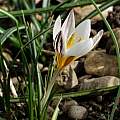
![Crocus thomasii, Angelo Porcelli [Shift+click to enlarge, Click to go to wiki entry] Crocus thomasii, Angelo Porcelli [Shift+click to enlarge, Click to go to wiki entry]](https://www.pacificbulbsociety.org/pbswiki/files/Crocus/th00---Crocus_thomasii_closeup.jpg.jpg?svg=600x450)
![Crocus tommasinianus closeup, Kelly Irvin [Shift+click to enlarge, Click to go to wiki entry] Crocus tommasinianus closeup, Kelly Irvin [Shift+click to enlarge, Click to go to wiki entry]](https://www.pacificbulbsociety.org/pbswiki/files/Crocus/th00---Crocus_tommasinianus_3.jpg.jpg?svg=300x300)
![Crocus tournefortii, Mary Sue Ittner [Shift+click to enlarge, Click to go to wiki entry] Crocus tournefortii, Mary Sue Ittner [Shift+click to enlarge, Click to go to wiki entry]](https://www.pacificbulbsociety.org/pbswiki/files/Crocus/th00---Crocus_tournefortii_msi.jpg.jpg?svg=640x527)
![Crocus vallicola, John Lonsdale [Shift+click to enlarge, Click to go to wiki entry] Crocus vallicola, John Lonsdale [Shift+click to enlarge, Click to go to wiki entry]](https://www.pacificbulbsociety.org/pbswiki/files/Crocus/th00---Crocus_vallicola_0004_jl.jpg.jpg?svg=550x413)
![Crocus veluchensis, John Lonsdale [Shift+click to enlarge, Click to go to wiki entry] Crocus veluchensis, John Lonsdale [Shift+click to enlarge, Click to go to wiki entry]](https://www.pacificbulbsociety.org/pbswiki/files/Crocus/th00---Crocus_veluchensis_0001_jl.jpg.jpg?svg=550x413)
![Crocus veneris, John Lonsdale [Shift+click to enlarge, Click to go to wiki entry] Crocus veneris, John Lonsdale [Shift+click to enlarge, Click to go to wiki entry]](https://www.pacificbulbsociety.org/pbswiki/files/Crocus/th00---Crocus_veneris_0002_jl.jpg.jpg?svg=550x413)
![Crocus vernus ssp.vernus 2, Arnold Trachtenberg [Shift+click to enlarge, Click to go to wiki entry] Crocus vernus ssp.vernus 2, Arnold Trachtenberg [Shift+click to enlarge, Click to go to wiki entry]](https://www.pacificbulbsociety.org/pbswiki/files/Crocus/th00---Crocus_vernus_ssp._vernus_3.jpg.jpg?svg=640x512)
![Crocus versicolor, Mary Sue Ittner [Shift+click to enlarge, Click to go to wiki entry] Crocus versicolor, Mary Sue Ittner [Shift+click to enlarge, Click to go to wiki entry]](https://www.pacificbulbsociety.org/pbswiki/files/Crocus/th00---Crocus_versicolor_msi.jpg.jpg?svg=640x530)
![Crocus vitellinus, Paige Woodward [Shift+click to enlarge, Click to go to wiki entry] Crocus vitellinus, Paige Woodward [Shift+click to enlarge, Click to go to wiki entry]](https://www.pacificbulbsociety.org/pbswiki/files/Crocus/th00---Crocus_vitellinus_PW3.jpg.jpg?svg=360x270)
![Crocus wattiorum, Jane McGary [Shift+click to enlarge, Click to go to wiki entry] Crocus wattiorum, Jane McGary [Shift+click to enlarge, Click to go to wiki entry]](https://www.pacificbulbsociety.org/pbswiki/files/Crocus/th00---Crocus_wattiorum_JMW2.jpg.jpg?svg=594x480)
![Crocus yakarianus, Hasan Yildirim [Shift+click to enlarge, Click to go to wiki entry] Crocus yakarianus, Hasan Yildirim [Shift+click to enlarge, Click to go to wiki entry]](https://www.pacificbulbsociety.org/pbswiki/files/Crocus/th00---Crocus_yakarianus_hy4.jpg.jpg?svg=640x425x1920x1275)
![Crocus yalovensis, Martin Bohnet [Shift+click to enlarge, Click to go to wiki entry] Crocus yalovensis, Martin Bohnet [Shift+click to enlarge, Click to go to wiki entry]](https://www.pacificbulbsociety.org/pbswiki/files/Crocus/th00---Crocus_yalovensis_mbt1.jpg.jpg?svg=412x550x800x1067)
![Crocus chrysanthus 'Advance', Mark McDonough [Shift+click to enlarge, Click to go to wiki entry] Crocus chrysanthus 'Advance', Mark McDonough [Shift+click to enlarge, Click to go to wiki entry]](https://www.pacificbulbsociety.org/pbswiki/files/Crocus/th00---Crocus_chrysanthus_Advance_2.jpg.jpg?svg=589x484)
![Crocus speciosus 'Aino', Paige Woodward [Shift+click to enlarge, Click to go to wiki entry] Crocus speciosus 'Aino', Paige Woodward [Shift+click to enlarge, Click to go to wiki entry]](https://www.pacificbulbsociety.org/pbswiki/files/Crocus/th00---Crocus_speciosus_Aino_PW.jpg.jpg?svg=285x368)
![C. cartwrightianus 'Albus', Arnold Trachtenberg [Shift+click to enlarge, Click to go to wiki entry] C. cartwrightianus 'Albus', Arnold Trachtenberg [Shift+click to enlarge, Click to go to wiki entry]](https://www.pacificbulbsociety.org/pbswiki/files/Crocus/th00---Crocus_cartwrightianus_Albus_1.jpg.jpg?svg=600x480)
![Crocus speciosus 'Artabir', Jane McGary [Shift+click to enlarge, Click to go to wiki entry] Crocus speciosus 'Artabir', Jane McGary [Shift+click to enlarge, Click to go to wiki entry]](https://www.pacificbulbsociety.org/pbswiki/files/Crocus/th00---Crocus_speciosus_Artabir.jpg.jpg?svg=582x480)
![Crocus tommasinianus, Barr's Purple, David Pilling [Shift+click to enlarge, Click to go to wiki entry] Crocus tommasinianus, Barr's Purple, David Pilling [Shift+click to enlarge, Click to go to wiki entry]](https://www.pacificbulbsociety.org/pbswiki/files/Crocus/th00---Crocus_tommasinianus_BarrsPurple_DP2.jpg.jpg?svg=640x513x1280x1026)
![Crocus minimus 'Bavella', Rimmer de Vries [Shift+click to enlarge, Click to go to wiki entry] Crocus minimus 'Bavella', Rimmer de Vries [Shift+click to enlarge, Click to go to wiki entry]](https://www.pacificbulbsociety.org/pbswiki/files/Crocus/th00---Crocus_minimus_Bavella_RdV0.jpg.jpg?svg=451x550x1051x1280)
![Crocus chrysanthus 'Blue Pearl', David Pilling [Shift+click to enlarge, Click to go to wiki entry] Crocus chrysanthus 'Blue Pearl', David Pilling [Shift+click to enlarge, Click to go to wiki entry]](https://www.pacificbulbsociety.org/pbswiki/files/Crocus/th00---Crocus_chrysanthus_BluePearl_DP0.jpg.jpg?svg=640x524x1280x1048)
![Crocus sieberi 'Bowles White', Tony Goode [Shift+click to enlarge, Click to go to wiki entry] Crocus sieberi 'Bowles White', Tony Goode [Shift+click to enlarge, Click to go to wiki entry]](https://www.pacificbulbsociety.org/pbswiki/files/Crocus/th00---Crocus_sieberiBowlesWhite.jpg.jpg?svg=600x450)
![Crocus angustifolius, Mary Sue Ittner [Shift+click to enlarge, Click to go to wiki entry] Crocus angustifolius, Mary Sue Ittner [Shift+click to enlarge, Click to go to wiki entry]](https://www.pacificbulbsociety.org/pbswiki/files/Crocus/th00---Crocus_angustifolius_msi2.jpg.jpg?svg=600x399)
![Crocus chrysanthus 'Cream Beauty', Janos Agoston [Shift+click to enlarge, Click to go to wiki entry] Crocus chrysanthus 'Cream Beauty', Janos Agoston [Shift+click to enlarge, Click to go to wiki entry]](https://www.pacificbulbsociety.org/pbswiki/files/Crocus/th00---Crocus_chrysanthus_Cream_Beauty_JA.jpg.jpg?svg=410x307)
![Crocus heuffelianus 'Dark Eyes', Arnold Trachtenberg [Shift+click to enlarge, Click to go to wiki entry] Crocus heuffelianus 'Dark Eyes', Arnold Trachtenberg [Shift+click to enlarge, Click to go to wiki entry]](https://www.pacificbulbsociety.org/pbswiki/files/Crocus/th00---Crocus_heuffelianus_Dark_Eyes.jpg.jpg?svg=440x550)
![Crocus chrysanthus 'Dorothy', David Pilling [Shift+click to enlarge, Click to go to wiki entry] Crocus chrysanthus 'Dorothy', David Pilling [Shift+click to enlarge, Click to go to wiki entry]](https://www.pacificbulbsociety.org/pbswiki/files/Crocus/th00---Crocus_chrysanthus_dorothy_DP2.jpg.jpg?svg=539x520)
![Crocus banaticus 'First Snow', Rimmer de Vries [Shift+click to enlarge, Click to go to wiki entry] Crocus banaticus 'First Snow', Rimmer de Vries [Shift+click to enlarge, Click to go to wiki entry]](https://www.pacificbulbsociety.org/pbswiki/files/Crocus/th00---Crocus_banaticus_FirstSnow_RdV0.jpg.jpg?svg=550x550x1280x1280)
![Crocus vernus 'Flower Record', David Pilling [Shift+click to enlarge, Click to go to wiki entry] Crocus vernus 'Flower Record', David Pilling [Shift+click to enlarge, Click to go to wiki entry]](https://www.pacificbulbsociety.org/pbswiki/files/Crocus/th00---Crocus_vernus_record_DP0.jpg.jpg?svg=459x540)
![Crocus laevigatus 'Fontenayi' in situ, Steve Burger [Shift+click to enlarge, Click to go to wiki entry] Crocus laevigatus 'Fontenayi' in situ, Steve Burger [Shift+click to enlarge, Click to go to wiki entry]](https://www.pacificbulbsociety.org/pbswiki/files/Crocus/th00---Crocus_laevigatus_Fontenayi_Closeup_SB.jpg.jpg?svg=640x480)
![Crocus ancyrensis, David Pilling [Shift+click to enlarge, Click to go to wiki entry] Crocus ancyrensis, David Pilling [Shift+click to enlarge, Click to go to wiki entry]](https://www.pacificbulbsociety.org/pbswiki/files/Crocus/th00---Crocus_ancyrensis_DP2.jpg.jpg?svg=613x550x1232x1105)
![Crocus chrysanthus 'Goldilocks', Mark McDonough [Shift+click to enlarge, Click to go to wiki entry] Crocus chrysanthus 'Goldilocks', Mark McDonough [Shift+click to enlarge, Click to go to wiki entry]](https://www.pacificbulbsociety.org/pbswiki/files/Crocus/th00---Crocus_chrysanthus_Goldilocks_1.jpg.jpg?svg=576x432)
![Crocus vernus 'Grand Maitre', David Pilling [Shift+click to enlarge, Click to go to wiki entry] Crocus vernus 'Grand Maitre', David Pilling [Shift+click to enlarge, Click to go to wiki entry]](https://www.pacificbulbsociety.org/pbswiki/files/Crocus/th00---Crocus_vernus_Grand_Maitre_DP0.jpg.jpg?svg=633x549)
![Crocus sieberi 'Hubert Edelsten', Tony Goode [Shift+click to enlarge, Click to go to wiki entry] Crocus sieberi 'Hubert Edelsten', Tony Goode [Shift+click to enlarge, Click to go to wiki entry]](https://www.pacificbulbsociety.org/pbswiki/files/Crocus/th00---Crocus_sieberiHubertEdelsten.jpg.jpg?svg=600x450)
![Crocus imperati 'Jager' closeup, Steve Burger [Shift+click to enlarge, Click to go to wiki entry] Crocus imperati 'Jager' closeup, Steve Burger [Shift+click to enlarge, Click to go to wiki entry]](https://www.pacificbulbsociety.org/pbswiki/files/Crocus/th00---Crocus_imperati_Jager_Closeup_SB.jpg.jpg?svg=640x480)
![Crocus vernus 'Jeanne d'Arc', David Pilling [Shift+click to enlarge, Click to go to wiki entry] Crocus vernus 'Jeanne d'Arc', David Pilling [Shift+click to enlarge, Click to go to wiki entry]](https://www.pacificbulbsociety.org/pbswiki/files/Crocus/th00---Crocus_vernus_Jeanne_Arc_DP1.jpg.jpg?svg=575x529)
![Crocus korolkowii 'Lucky Number', John Lonsdale [Shift+click to enlarge, Click to go to wiki entry] Crocus korolkowii 'Lucky Number', John Lonsdale [Shift+click to enlarge, Click to go to wiki entry]](https://www.pacificbulbsociety.org/pbswiki/files/Crocus/th00---Crocus_korolkowii_Lucky_Number_0002_jl.jpg.jpg?svg=640x480)
![Crocus goulimyi 'Mani White', Mary Sue Ittner [Shift+click to enlarge, Click to go to wiki entry] Crocus goulimyi 'Mani White', Mary Sue Ittner [Shift+click to enlarge, Click to go to wiki entry]](https://www.pacificbulbsociety.org/pbswiki/files/Crocus/th00---Crocus_goulimyi_ManiWhite_msi.jpg.jpg?svg=598x550)
![Crocus vernus 'Pickwick', David Pilling [Shift+click to enlarge, Click to go to wiki entry] Crocus vernus 'Pickwick', David Pilling [Shift+click to enlarge, Click to go to wiki entry]](https://www.pacificbulbsociety.org/pbswiki/files/Crocus/th00---Crocus_vernus_pickwick_DP2.jpg.jpg?svg=567x542)
![Crocus serotinus 'Poseidon', Mark McDonough [Shift+click to enlarge, Click to go to wiki entry] Crocus serotinus 'Poseidon', Mark McDonough [Shift+click to enlarge, Click to go to wiki entry]](https://www.pacificbulbsociety.org/pbswiki/files/Crocus/th00---Crocus_serotinus_Poseidon_2005b.jpg.jpg?svg=578x448)
![Crocus chrysanthus 'Prins Claus', Mark McDonough [Shift+click to enlarge, Click to go to wiki entry] Crocus chrysanthus 'Prins Claus', Mark McDonough [Shift+click to enlarge, Click to go to wiki entry]](https://www.pacificbulbsociety.org/pbswiki/files/Crocus/th00---Crocus_Prins_Claus_overhead.jpg.jpg?svg=576x444)
![Crocus kotschyanus 'Reliant', Mark McDonough [Shift+click to enlarge, Click to go to wiki entry] Crocus kotschyanus 'Reliant', Mark McDonough [Shift+click to enlarge, Click to go to wiki entry]](https://www.pacificbulbsociety.org/pbswiki/files/Crocus/th00---Crocus_kot_var_kot_Reliant_c.jpg.jpg?svg=576x432)
![Crocus chrysanthus 'Romance', David Pilling [Shift+click to enlarge, Click to go to wiki entry] Crocus chrysanthus 'Romance', David Pilling [Shift+click to enlarge, Click to go to wiki entry]](https://www.pacificbulbsociety.org/pbswiki/files/Crocus/th00---Crocus_chrysanthus_Romance_DP0.jpg.jpg?svg=607x546)
![Crocus tommasinianus 'Ruby Giant', Jay Yourch [Shift+click to enlarge, Click to go to wiki entry] Crocus tommasinianus 'Ruby Giant', Jay Yourch [Shift+click to enlarge, Click to go to wiki entry]](https://www.pacificbulbsociety.org/pbswiki/files/Crocus/th00---Crocus_tommasinianus_RubyGiant-JAY.jpg.jpg?svg=640x480)
![Crocus sieberi ssp. sublimus 'Tricolor' 27th February 2013, David Pilling [Shift+click to enlarge, Click to go to wiki entry] Crocus sieberi ssp. sublimus 'Tricolor' 27th February 2013, David Pilling [Shift+click to enlarge, Click to go to wiki entry]](https://www.pacificbulbsociety.org/pbswiki/files/Crocus/th00---Crocus_sieberi_sublimus_Tricolor_DP3.jpg.jpg?svg=571x550x1280x1231)
![Crocus tommasinianus Whitewell Purple, 18th February 2016, David Pilling [Shift+click to enlarge, Click to go to wiki entry] Crocus tommasinianus Whitewell Purple, 18th February 2016, David Pilling [Shift+click to enlarge, Click to go to wiki entry]](https://www.pacificbulbsociety.org/pbswiki/files/Crocus/th00---Crocus_tommasinianus_Whitewell_Purple_DP2.jpg.jpg?svg=514x550x748x800)
![Crocus tommasinianus Yalta, 8th March 2014, David Pilling [Shift+click to enlarge, Click to go to wiki entry] Crocus tommasinianus Yalta, 8th March 2014, David Pilling [Shift+click to enlarge, Click to go to wiki entry]](https://www.pacificbulbsociety.org/pbswiki/files/Crocus/th00---Crocus_tommasinianus_Yalta_DP2.jpg.jpg?svg=566x550x1200x1166)
![Crocus 'Yellow Mammoth', David Pilling [Shift+click to enlarge, Click to go to wiki entry] Crocus 'Yellow Mammoth', David Pilling [Shift+click to enlarge, Click to go to wiki entry]](https://www.pacificbulbsociety.org/pbswiki/files/Crocus/th00---Crocus_Yellow_Mammoth_DP0.jpg.jpg?svg=455x518)
![Crocus chrysanthus unknown cultivar, David Pilling [Shift+click to enlarge, Click to go to wiki entry] Crocus chrysanthus unknown cultivar, David Pilling [Shift+click to enlarge, Click to go to wiki entry]](https://www.pacificbulbsociety.org/pbswiki/files/Crocus/th00---Crocus_chrysanthus_Zwanenberg_DP5.jpg.jpg?svg=640x503x1280x1007)